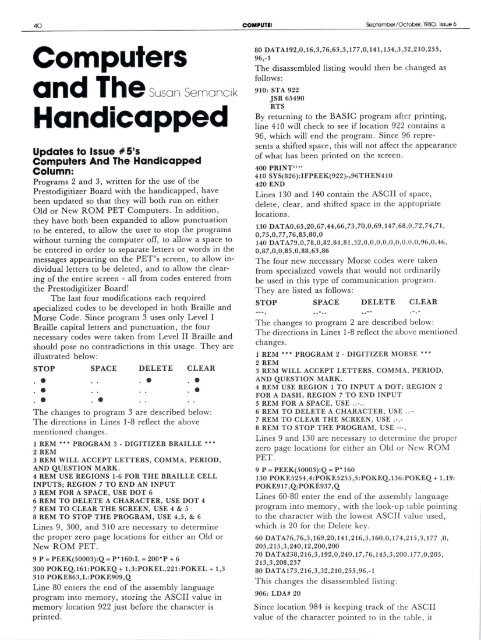The Resource Magazine For Apple, Atari, and Commodore ...
The Resource Magazine For Apple, Atari, and Commodore ...
The Resource Magazine For Apple, Atari, and Commodore ...
Create successful ePaper yourself
Turn your PDF publications into a flip-book with our unique Google optimized e-Paper software.
4O COMPUTE! September/October. 199O. Issued<br />
Computers<br />
CHlGI I II© >usan Semancik<br />
H<strong>and</strong>icapped<br />
Updates to Issue #5's<br />
Computers And <strong>The</strong> H<strong>and</strong>icapped<br />
Column:<br />
Programs 2 <strong>and</strong> 3, written for the use of the<br />
Prestodigitizer Board with the h<strong>and</strong>icapped, have<br />
been updated so that they will both run on either<br />
Old or New ROM PET Computers. In addition,<br />
they have both been exp<strong>and</strong>ed to allow punctuation<br />
to be entered, to allow the user to stop the programs<br />
without turning the computer off, to allow a space to<br />
be entered in order to separate letters or words in the<br />
messages appearing on the PET's screen, to allow in<br />
dividual letters to be deleted, <strong>and</strong> to allow the clear<br />
ing of the entire screen - all from codes entered from<br />
the Prestodigitizer Board!<br />
<strong>The</strong> last four modifications each required<br />
specialized codes to be developed in both Braille <strong>and</strong><br />
Morse Code. Since program 3 uses only Level I<br />
Braille capital letters <strong>and</strong> punctuation, the four<br />
necessary codes were taken from Level II Braille <strong>and</strong><br />
should pose no contradictions in this usage. <strong>The</strong>y are<br />
illustrated<br />
below:<br />
STOP SPACE DELETE CLEAR<br />
<strong>The</strong> changes to program 3 are described below:<br />
<strong>The</strong> directions in Lines 1-8 reflect the above<br />
mentioned<br />
changes.<br />
1 REM '" PROGRAM 3 - DIGITIZER BRAILLE ••■<br />
2 REM<br />
3 REM WILL ACCEPT LETTERS, COMMA, PERIOD,<br />
AND QUESTION MARK.<br />
4 REM USE REGIONS 1-6 FOR THE BRAILLE CELL<br />
INPUTS; REGION 7 TO END AN INPUT<br />
5 REM FOR A SPACE, USE DOT 6<br />
6 REM TO DELETE A CHARACTER, USE DOT 4<br />
7 REM TO CLEAR THE SCREEN, USE 4 & 5<br />
8 REM TO STOP THE PROGRAM, USE 4,5, & 6<br />
Lines 9, 300, <strong>and</strong> 310 are necessary to determine<br />
the proper zero page locations for either an Old or<br />
New ROM PET.<br />
9 P = PEEK(50003):Q = P'160:L = 200"P + 6<br />
300 POKEQ,161:POKEQ+ 1,3:POKEL,221:POKEL + 1,3<br />
310 POKE863,L:POKE909,Q<br />
Line 80 enters the end of the assembly language<br />
program into memory, storing the ASCII value in<br />
memory location 922 just before the character is<br />
printed.<br />
80 DATA192,0,16,3,76,63,3,177,0,141,154,3,32,210,255,<br />
96,-1<br />
<strong>The</strong> disassembled listing would then be changed as<br />
follows:<br />
910: STA 922<br />
JSR 65490<br />
RTS<br />
By returning to the BASIC program after printing,<br />
line 410 will check to see if location 922 contains a<br />
96, which will end the program. Since 96 repre<br />
sents a shifted space, this will not affect the appearance<br />
of what has been printed on the screen.<br />
400 PRINT""<br />
410 SYS(826):IFPEEK(922)96THEN410<br />
420 END<br />
Lines 130 <strong>and</strong> 140 contain the ASCII of space,<br />
delete, clear, <strong>and</strong> shifted space in the appropriate<br />
locations.<br />
130 DATA0,65,20,67.44,66,73,70,0,69,147,68.0,72,74,71,<br />
0,75,0,77,76,83,80,0<br />
140 DATA79,O,78,0,82.84.81,32.0,0,0.0.0.0.0.0,0,96,0,46,<br />
0,87,0,0.85,0,88,63.86<br />
<strong>The</strong> four new necessary Morse codes were taken<br />
from specialized vowels that would not ordinarily<br />
be used in this type of communication program.<br />
<strong>The</strong>y are listed as follows:<br />
STOP SPACE DELETE CLEAR<br />
<strong>The</strong> changes to program 2 are described below:<br />
<strong>The</strong> directions in Lines 1-8 reflect the above mentioned<br />
changes.<br />
1 REM ••• PROGRAM 2 - DIGITIZER MORSE •••<br />
2 REM<br />
3 REM WILL ACCEPT LETTERS, COMMA. PERIOD,<br />
AND QUESTION MARK.<br />
4 REM USE REGION 1 TO INPUT A DOT; REGION 2<br />
FOR A DASH, REGION 7 TO END INPUT<br />
5 REM FOR A SPACE, USE ....<br />
6 REM TO DELETE A CHARACTER, USE ..--<br />
7 REM TO CLEAR THE SCREEN, USE .-.-<br />
8 REM TO STOP THE PROGRAM, USE ---.<br />
Lines 9 <strong>and</strong> 130 are necessary to determine the proper<br />
zero page locations for either an Old or New ROM<br />
PET.<br />
9 P = PEEK(50003):Q, = P* 160<br />
130 POKE5254.4:POKE5255,5:POKEQ_,136:I>OKEQ.+ 1,19:<br />
POKE917,Q:POKE937,Q<br />
Lines 60-80 enter the end of the assembly language<br />
program into memory, with the look-up table pointing<br />
to the character with the lowest ASCII value used,<br />
which is 20 for the Delete key.<br />
60 DATA76,76,3,169.20,141,216,3,160,0,174,215.3,177 ,0,<br />
205,215,3,240,12,200,200<br />
70 DATA238,216,3,192,0,240.17,76,145.3.200.177.0.205,<br />
213.3,208,237<br />
80 DATA173,216,3,32,210,255,96.-1<br />
This changes the disassembled listing:<br />
906: LDA# 20<br />
Since location 984 is keeping track of the ASCII<br />
value of the character pointed to in the table, it

















